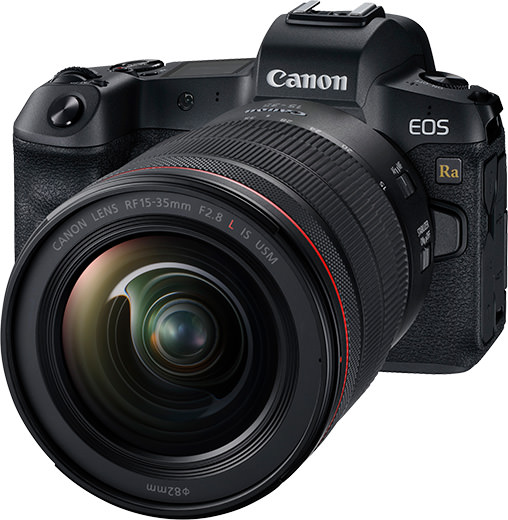 Japan
Japan Americas
Americas Europe, Asia, Oceania
Europe, Asia, Oceania
- Outline
| Marketed | December 2019 * Not available in some parts of China |
| Original Price | Open price |
| Specifications | Open PDF* (119KB)  , (372KB) , (372KB)  * PDF of EOS R and its differences |
The EOS Ra, a full-frame mirrorless camera designed for use in astrophotography1. Ideal for enthusiast photographers who enjoy capturing the night sky, the new specialized camera features a full-frame CMOS sensor with up to approximately 30.3 million effective pixels2 and optical characteristics tailored for astrophotography, enabling red nebulae and other astronomical phenomena to be vividly photographed in high resolution.
Based on Canon’s EOS R mirrorless interchangeable-lens camera, released in October 2018, the EOS Ra’s modified infrared (IR) blocking filter, positioned in front of the CMOS sensor, features characteristics that increase the transmission of light at the Hydrogen Alpha line wavelength, or H-α wavelength3, by a factor of approximately 4x compared with the EOS R. In addition, the camera’s CMOS sensor and DIGIC 8 image processor make possible low-noise shooting and a maximum normal high sensitivity of ISO40000. Thanks to these capabilities, users can capture vivid, high-resolution photographs of such subjects with strong red tinges as the Lagoon Nebula (M8), the Trifid Nebula (M20) and the Carina Nebula.
The compact and lightweight EOS Ra is equipped with a vari-angle LCD monitor that enables use of live-view and adjustment of image-capture settings, even when the camera is attached to a tripod. What’s more, magnification in live-mode viewing can be increased from the maximum 10x of the EOS R to a maximum of 30x. This increased magnification allows small stars to appear larger on the LCD screen, enabling more precise focus selection when photographing astral bodies.
1 As the EOS Ra is intended specifically for astrophotography, it is not recommended for standard photography use. If used to photograph conventional subjects, the camera may not achieve optimal color balance, resulting in images with a reddish tinge.
2 Rounded upwards to nearest 0.1 million pixels. Effective pixel count may vary depending on the attached EF/RF lens and/or image processing. Actual pixel count: approximately 31.7 million pixels.
3 One of the wavelengths emitted by nebulae and other astral bodies.


